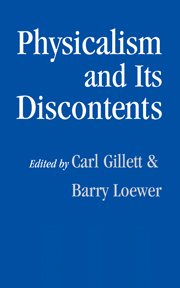Book contents
- Frontmatter
- Contents
- Contributors
- Preface
- Part I Physicalism
- Part II Physicalist Discontents
- Part III Physicalism and Consciousness: A Continuing Dialectic
- 13 Mental Causation and Consciousness: The Two Mind-Body Problems for the Physicalist
- 14 How Not to Solve the Mind-Body Problem
- 15 Deconstructing New Wave Materialism
- 16 In Defense of New Wave Materialism: A Response to Horgan and Tienson
- 17 Physicalism Unfalsified: Chalmers's Inconclusive Conceivability Argument
- References
- Index
15 - Deconstructing New Wave Materialism
Published online by Cambridge University Press: 02 November 2009
- Frontmatter
- Contents
- Contributors
- Preface
- Part I Physicalism
- Part II Physicalist Discontents
- Part III Physicalism and Consciousness: A Continuing Dialectic
- 13 Mental Causation and Consciousness: The Two Mind-Body Problems for the Physicalist
- 14 How Not to Solve the Mind-Body Problem
- 15 Deconstructing New Wave Materialism
- 16 In Defense of New Wave Materialism: A Response to Horgan and Tienson
- 17 Physicalism Unfalsified: Chalmers's Inconclusive Conceivability Argument
- References
- Index
Summary
In the first post World War II identity theories (e.g., Place [1956], Smart [1962]), mind-brain identities were held to be contingent. However, in work beginning in the late 1960s, Saul Kripke ([1971], [1980]) convinced the philosophical community that true identity statements involving names and natural kind terms are necessarily true and, furthermore, that many such necessary identities can only be known a posteriori. Kripke also offered an explanation of the a posteriori nature of ordinary theoretical identities such as that water = H2O. We identify the kinds and substances involved in theoretical identities by certain of their contingent properties. What we discover when we discover a theoretical identity is the underlying nature of the kind that we identify by those contingent properties.
Now, of course, it was being a posteriori, not being contingent, that mattered to the identity theorists anyway, so the necessity of identity is not, in itself, damaging to mind-brain identity theories. However, Kripke also argued persuasively that the alleged mind-brain identities could not be treated in the same way as ordinary theoretical identities. We “identify” pain by feeling it, and surely how it feels is an essential property of pain, not a contingent property. Thus, a mind-body identity theory must provide a different explanation of why its identities are a posteriori.
A new wave of materialists has appeared on the scene with a new strategy for explaining the a posteriori nature of its alleged identities. The strategy is to locate the explanation for the a posteriori nature of mind-body identities, not on the side of the world, but on the side of the mind – in different ways of thinking about or imagining, or in different concepts.
- Type
- Chapter
- Information
- Physicalism and its Discontents , pp. 307 - 318Publisher: Cambridge University PressPrint publication year: 2001
- 20
- Cited by



